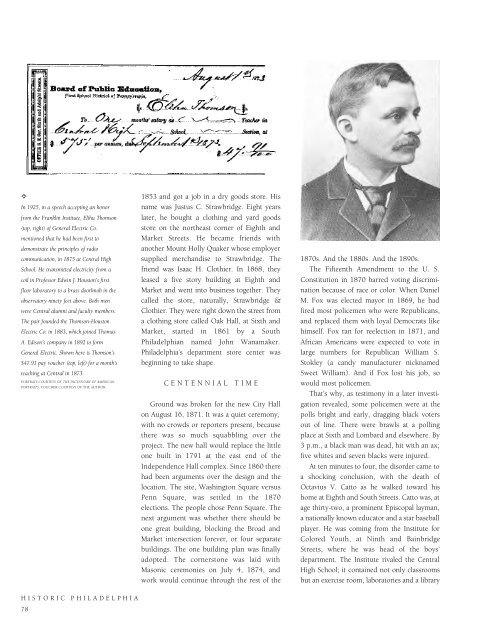Historic Philadelphia
An illustrated history of the city of Philadelphia, paired with the histories of companies, families and organizations that make the region great.
An illustrated history of the city of Philadelphia, paired with the histories of companies, families and organizations that make the region great.
You also want an ePaper? Increase the reach of your titles
YUMPU automatically turns print PDFs into web optimized ePapers that Google loves.
✧<br />
In 1925, in a speech accepting an honor<br />
from the Franklin Institute, Elihu Thomson<br />
(top, right) of General Electric Co.<br />
mentioned that he had been first to<br />
demonstrate the principles of radio<br />
communication, in 1875 at Central High<br />
School. He transmitted electricity from a<br />
coil in Professor Edwin J. Houston’s first<br />
floor laboratory to a brass doorknob in the<br />
observatory ninety feet above. Both men<br />
were Central alumni and faculty members.<br />
The pair founded the Thomson-Houston<br />
Electric Co. in 1883, which joined Thomas<br />
A. Edison’s company in 1892 to form<br />
General Electric. Shown here is Thomson’s<br />
$47.91 pay voucher (top, left) for a month’s<br />
teaching at Central in 1873.<br />
PORTRAIT COURTESY OF THE DICTIONARY OF AMERICAN<br />
PORTRAITS. VOUCHER COURTESY OF THE AUTHOR.<br />
HISTORIC PHILADELPHIA<br />
78<br />
1853 and got a job in a dry goods store. His<br />
name was Justus C. Strawbridge. Eight years<br />
later, he bought a clothing and yard goods<br />
store on the northeast corner of Eighth and<br />
Market Streets. He became friends with<br />
another Mount Holly Quaker whose employer<br />
supplied merchandise to Strawbridge. The<br />
friend was Isaac H. Clothier. In 1868, they<br />
leased a five story building at Eighth and<br />
Market and went into business together. They<br />
called the store, naturally, Strawbridge &<br />
Clothier. They were right down the street from<br />
a clothing store called Oak Hall, at Sixth and<br />
Market, started in 1861 by a South<br />
<strong>Philadelphia</strong>n named John Wanamaker.<br />
<strong>Philadelphia</strong>’s department store center was<br />
beginning to take shape.<br />
CENTENNIAL<br />
TIME<br />
Ground was broken for the new City Hall<br />
on August 16, 1871. It was a quiet ceremony,<br />
with no crowds or reporters present, because<br />
there was so much squabbling over the<br />
project. The new hall would replace the little<br />
one built in 1791 at the east end of the<br />
Independence Hall complex. Since 1860 there<br />
had been arguments over the design and the<br />
location. The site, Washington Square versus<br />
Penn Square, was settled in the 1870<br />
elections. The people chose Penn Square. The<br />
next argument was whether there should be<br />
one great building, blocking the Broad and<br />
Market intersection forever, or four separate<br />
buildings. The one building plan was finally<br />
adopted. The cornerstone was laid with<br />
Masonic ceremonies on July 4, 1874, and<br />
work would continue through the rest of the<br />
1870s. And the 1880s. And the 1890s.<br />
The Fifteenth Amendment to the U. S.<br />
Constitution in 1870 barred voting discrimination<br />
because of race or color. When Daniel<br />
M. Fox was elected mayor in 1869, he had<br />
fired most policemen who were Republicans,<br />
and replaced them with loyal Democrats like<br />
himself. Fox ran for reelection in 1871, and<br />
African Americans were expected to vote in<br />
large numbers for Republican William S.<br />
Stokley (a candy manufacturer nicknamed<br />
Sweet William). And if Fox lost his job, so<br />
would most policemen.<br />
That’s why, as testimony in a later investigation<br />
revealed, some policemen were at the<br />
polls bright and early, dragging black voters<br />
out of line. There were brawls at a polling<br />
place at Sixth and Lombard and elsewhere. By<br />
3 p.m., a black man was dead, hit with an ax;<br />
five whites and seven blacks were injured.<br />
At ten minutes to four, the disorder came to<br />
a shocking conclusion, with the death of<br />
Octavius V. Catto as he walked toward his<br />
home at Eighth and South Streets. Catto was, at<br />
age thirty-two, a prominent Episcopal layman,<br />
a nationally known educator and a star baseball<br />
player. He was coming from the Institute for<br />
Colored Youth, at Ninth and Bainbridge<br />
Streets, where he was head of the boys’<br />
department. The Institute rivaled the Central<br />
High School; it contained not only classrooms<br />
but an exercise room, laboratories and a library
















